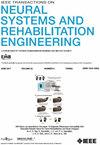Performance Enhancement of an SSVEP-Based Brain–Computer Interface in Augmented Reality Through Adaptive Color Adjustment of Visual Stimuli for Optimal Background Contrast
IF 4.8
2区 医学
Q2 ENGINEERING, BIOMEDICAL
IEEE Transactions on Neural Systems and Rehabilitation Engineering
Pub Date : 2025-01-20
DOI:10.1109/TNSRE.2025.3530421
引用次数: 0
Abstract
The aim of this study is to develop a steady-state visual evoked potential (SSVEP)-based brain-computer interface (BCI) system with enhanced performance in an augmented reality (AR) environment by dynamically adjusting colors of visual stimuli to contrast with the background seen through the transparent display. Our proposed method extracts the average color value from the area surrounding the visual stimulus location. It then calculates the contrast value using the HSV color model and applies this to the stimulus color. In an offline experiment, we determined the optimal visual stimulus presentation strategy by comparing the performances of three different methods for determining the colors of visual stimuli in an AR environment. We then evaluated the feasibility of the proposed strategy through online experiments conducted in both indoor and outdoor conditions. The classification performance of the SSVEP-BCI system in an AR environment based on our proposed stimulus presentation strategy was 95.0% for a window size of 3.5 s in offline experiments performed with 17 participants. This was significantly higher than the performance of the conventional black-and-white color strategy. Additionally, it was confirmed by the online experiments that there was no large performance degradation between indoor and outdoor uses.本研究旨在开发一种基于稳态视觉诱发电位(SSVEP)的脑机接口(BCI)系统,通过动态调整视觉刺激物的颜色,使其与通过透明显示屏看到的背景形成对比,从而增强增强现实(AR)环境中的性能。我们提出的方法是从视觉刺激位置周围区域提取平均颜色值。然后使用 HSV 色彩模型计算对比度值,并将其应用于刺激物颜色。在离线实验中,我们通过比较在 AR 环境中确定视觉刺激颜色的三种不同方法的性能,确定了最佳视觉刺激呈现策略。然后,我们通过在室内和室外条件下进行的在线实验评估了所提策略的可行性。在有 17 名参与者参加的离线实验中,基于我们提出的刺激呈现策略,SSVEP-BCI 系统在 AR 环境中的分类性能在窗口大小为 3.5 秒时达到了 95.0%。这明显高于传统的黑白颜色策略。此外,在线实验还证实,室内和室外使用时的性能没有大幅下降。
本文章由计算机程序翻译,如有差异,请以英文原文为准。
求助全文
约1分钟内获得全文
求助全文
来源期刊
CiteScore
8.60
自引率
8.20%
发文量
479
审稿时长
6-12 weeks
期刊介绍:
Rehabilitative and neural aspects of biomedical engineering, including functional electrical stimulation, acoustic dynamics, human performance measurement and analysis, nerve stimulation, electromyography, motor control and stimulation; and hardware and software applications for rehabilitation engineering and assistive devices.

 求助内容:
求助内容: 应助结果提醒方式:
应助结果提醒方式:


